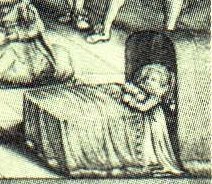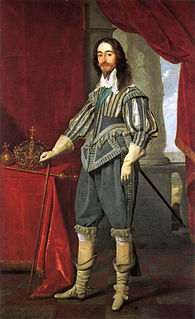 W
WJames VI and I was King of Scotland as James VI from 24 July 1567 and King of England and Ireland as James I from the union of the Scottish and English crowns on 24 March 1603 until his death in 1625. The kingdoms of Scotland and England were individual sovereign states, with their own parliaments, judiciaries, and laws, though both were ruled by James in personal union.
 W
WAnne of Denmark was Queen consort of Scotland, England, and Ireland by marriage to King James VI and I.
 W
WCalvin's Case (1608), 77 ER 377, (1608) Co Rep 1a, also known as the Case of the Postnati, was a 1608 English legal decision establishing that a child born in Scotland, after the Union of the Crowns under James VI and I in 1603, was considered under the common law to be an English subject and entitled to the benefits of English law. Calvin's Case was eventually adopted by courts in the United States, and the case played an important role in shaping the American rule of birthright citizenship via jus soli. However, the case has also been cited as providing legal justification for the restriction of legal rights to Native Americans following their widespread conquest or confinement in reservations by the colonial forces of North America.
 W
WEarl of Oxford's case (1615) 21 ER 485 is a foundational case for the common law world, that held equity takes precedence over the common law.
 W
WThe Five Articles of Perth was an attempt by King James VI of Scotland to impose practices on the Church of Scotland in an attempt to integrate it with those of the Church of England. This move was unpopular with those Scots who held Reformed views on worship, and with those who supported presbyterian church governance.
 W
WThe Jacobean debate on the Union took place in the early years of the reign of James I of England, who came to the English throne in 1603 as James VI of Scotland, and was interested in uniting his kingdoms of England and Scotland. With one monarch on the two thrones there was de facto a "regnal union"; since James was very widely accepted in England the debate was not on that plane. A political union was more controversial: it is often referred to as a "statutory union", underlining the fact that the legal systems and institutions involved were different, and had had distinct historical paths. This wider union did not in fact come about in the 17th century ; but at the time of the Union of England and Scotland in 1707 arguments from this earlier period were again put into circulation.
 W
WThe Jacobean era was the period in English and Scottish history that coincides with the reign of James VI of Scotland who also inherited the crown of England in 1603 as James I. The Jacobean era succeeds the Elizabethan era and precedes the Caroline era. The term "Jacobean" is often used for the distinctive styles of Jacobean architecture, visual arts, decorative arts, and literature which characterized that period.
 W
WJames VI and I, King of Scots, King of England, and king of Ireland, faced many complicated religious challenges during his reigns in Scotland and England.
 W
WJames I, the first king to reign in both England and Scotland, faced many difficulties with the Parliament of England. Though recent studies have shown that the Parliament of Scotland may have been more of a thorn in his side than was previously believed, James developed his political philosophy of the relationship between monarch and parliament in Scotland and never reconciled himself to the independent stance of the English Parliament and its unwillingness to bow readily to his policies.
 W
WJames VI and I, the only child of Mary, Queen of Scots, was King of Scots from 1567 and King of England and Ireland from 1603, being the first monarch of the House of Stuart to rule all three countries. His descendants include Elizabeth II of the United Kingdom, Philippe of Belgium, Felipe VI of Spain, Carl XVI Gustaf of Sweden, Margrethe II of Denmark, Harald V of Norway, Willem-Alexander of the Netherlands, and Henri, Grand Duke of Luxembourg. This article deals with numerous descendants of James and his wife Anne of Denmark.
 W
WThe James River is a river in the U.S. state of Virginia that begins in the Appalachian Mountains and flows 348 miles (560 km) to Chesapeake Bay. The river length extends to 444 miles (715 km) if one includes the Jackson River, the longer of its two source tributaries. It is the longest river in Virginia. Jamestown and Williamsburg, Virginia’s first colonial capitals, and Richmond, Virginia's current capital, lie on the James River.
 W
WKing James VI Golf Club, located in Perth, Scotland, is a private golf course also open to visitors. The River Tay setting is notable as it is the country's only self-contained course on a river island. The Island course is only accessible by foot by a side-walk on the side of a train bridge crossing the River Tay.
 W
WThe Oath of Allegiance of 1606 was an oath requiring English Catholics to swear allegiance to James I over the Pope. It was adopted by Parliament the year after the Gunpowder Plot of 1605. The oath was proclaimed law on 22 June, 1606; it was also called the Oath of Obedience. Whatever effect it had on the loyalty of his subjects, it caused an international controversy lasting a decade and more.
 W
WSophia Stuart was the fourth daughter and seventh and final child of King James VI and I by his wife Anne of Denmark. She was born at Greenwich Palace on 22 June 1606 and died there the next day. Alice Dennis was the midwife, she had also attended the birth of Princess Mary in April 1605.
 W
WThe Spanish match was a proposed marriage between Prince Charles, the son of King James I of Great Britain, and Infanta Maria Anna of Spain, the daughter of Philip III of Spain. Negotiations took place over the period 1614 to 1623, and during this time became closely related to aspects of British foreign and religious policy, before breaking down completely.
 W
WThe Union of the Crowns was the accession of James VI of Scotland to the thrones of England and Ireland as James I, and the consequential unification for some purposes of the three realms under a single monarch on 24 March 1603. The Union of the Crowns followed the death of James's cousin, Elizabeth I of England, the last monarch of the Tudor dynasty.
 W
W